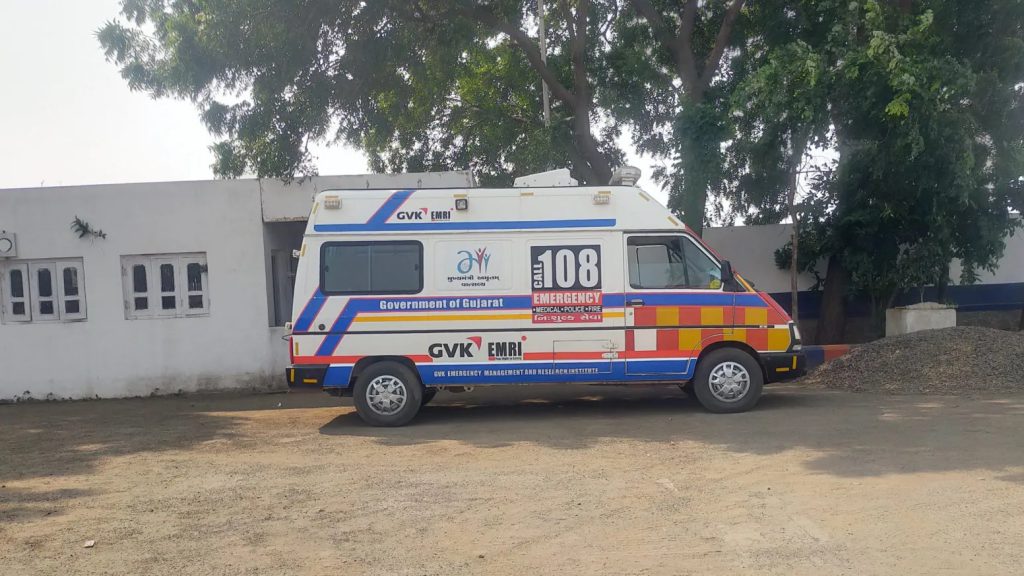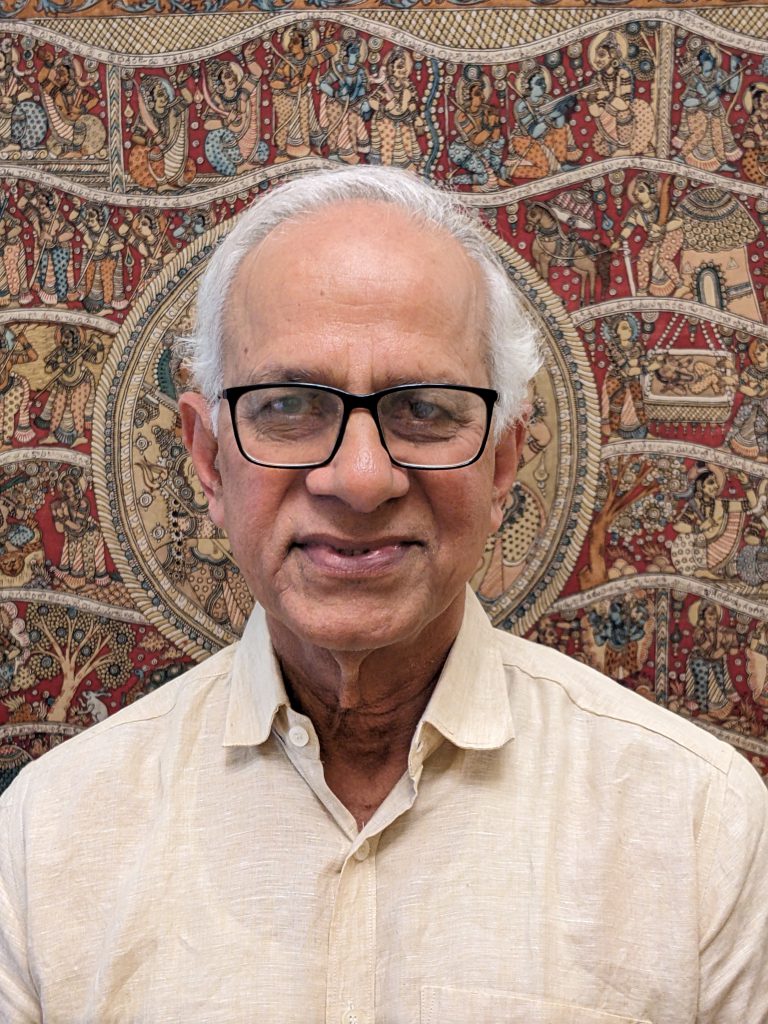Alumnus Sudhakar Varanasi recounts the history and impact of India’s 108 ambulance service

It was a day like any other in the year 2001 when Barbara and her daughter set out on a drive to the suburbs of Bangalore. Unfortunately, their car met with an accident, leaving Barbara bleeding profusely and severely injured. Her daughter, physically unharmed, sat by her mother’s side, an overwhelmin sense of fear and despair washing over her. She pleaded with the people who had gathered around to call for an ambulance. But the bystanders kept giving just one suggestion: Call the police.
In those days, that was the protocol in effect across India. The police had to intervene before transporting the victim of an accident to the nearest hospital as it was a medico-legal case, and doctors would refrain from providing treatment until the police arrived.
In Barbara’s case, when a policeman finally arrived, he came on a motorcycle. He assessed the accident scene but was unable to transport the injured Barbara by himself, so he went back to arrange for a police jeep, leaving her and her distressed daughter in limbo. Barbara eventually lost her life.
Sudhakar Varanasi, a close family friend of Barbara, was greatly saddened by this tragic turn of events. His grief deepened when he learned that it was a consequence of delayed medical attention. It stirred something within Sudhakar. Something had to be done to change the status quo, he thought. It was this reflection that motivated Sudhakar to embark upon a project to revitalise the country’s emergency response system.
On 15 August 2005, the 108 emergency services project was formally launched. A new number, 108, was formally introduced as an emergency hotline and a single point of contact for police, fire and medical emergency services.
To this day, the helpline continues to save countless lives. In contrast to the previous emergency number, 100, which had limited lines and was answered by the police directly, 108 was more efficient because it integrated all the emergency services – police, fire and medical emergencies – into one. Thousands of calls every day in every state in India to 108 call centres are handled by trained professionals who can effectively address and coordinate a multitude of emergency situations simultaneously.
108 integrated all the emergency services – police, fire and medical emergencies – into one
“Despite India having separate phone numbers for calling the police (100) and the fire service (101), the country lacked a single, unified and efficient emergency service similar to 911 in the USA or 112 in various parts of Europe,” Sudhakar recollects.
Sudhakar first came to IISc to pursue his PhD from the Molecular Biophysics Unit, after five years of education at IIT Kharagpur. After his graduation in 1983, he worked briefly in the Department of Aerospace Engineering as a postdoctoral scholar. “From academia, I shifted to the corporate world after IISc, eventually working as the CEO in a few organisations,” Sudhakar says. He was a founding director of Tiger Software before moving on to Satyam Computer Services. The IT boom in India created tremendous opportunities for both the Indian IT industry and thousands of individuals who secured jobs abroad. It was a game-changer, instilling a sense of accomplishment and empowerment in those who had previously felt stifled by economic constraints, explains Sudhakar.
“My professional journey is quite common, shared by millions of individuals in the IT sector. It was during this period that my experience and, perhaps notably, my grey hair became an asset,” says Sudhakar, jokingly. “I assumed a senior management role not necessarily because of exceptional intelligence, but because the industry required individuals who could grasp the broader perspective of computers and how to navigate and utilise them effectively,” he adds. “It was a period of continuous learning, a process that eventually made me stand out in the corporate world.”
But despite his professional success in the IT sector, Sudhakar was drawn to the idea of social service. “I’ve often grappled with the question of whether it’s justifiable to dedicate my life to in-depth research on the minutiae of the physical world. Especially in a country like India, where millions are uneducated, and many live below the poverty line, is it fair to concentrate all my efforts on delving into the deepest recesses of scientific knowledge, publishing papers that only a handful of international scientists might read? Especially in a country like India with many budget constraints? Is it a justifiable use of the resources invested in my education by the Government of India and the substantial subsidies provided here? These questions poked at my consciousness.”

Around 2004, Satyam Computers had just grown into a billion-dollar enterprise. Sudhakar proposed the idea of a free ambulance and medical service to his boss, who was totally supportive. Sudhakar was encouraged strongly by his Chairman who provided a large fund from Satyam and his personal friends in the industry. He was asked to find a revenue model to ensure sustainability of this project later.
The amount was significant, but considering the scope of the project – each ambulance alone cost about Rs 20 lakh – they needed more funds. To provide efficient ambulance services over a large area, they had to divide the cities into cells and locate the ambulances in each one. This required 150 to 200 ambulances, which, along with other expenses, exceeded the initial budget.
“We began in Hyderabad, where the company headquarters was located. We had a decent team with a growth mind-set – people willing to admit that they didn’t have all the answers but committed to figuring things out. We had to address numerous questions and challenges, many of which were uncharted territory,” he explains.
Sudhakar and his team approached the then government of (undivided) Andhra Pradesh. The political climate at the time, Sudhakar says, was conducive for new initiatives. The growing importance of computers and the IT industry in Hyderabad had a direct impact on a fully technology-driven ambulance service. With around 30,000 people employed in the IT sector, there was expertise available. This meant that the ambulance service could benefit from the emerging information technologies of that time, the use of computers enhancing the speed, accuracy, and overall effectiveness of the ambulance project. YS Rajasekhar Reddy, the then Chief Minister of (undivided) Andhra Pradesh, saw potential in their proposal and agreed to support them.
The growing importance of computers and the IT industry in Hyderabad had a direct impacton a fully technology-driven ambulance service
Towards the end of the first year, people started taking notice of their efforts. Other states began to inquire about the system. Newspapers reported on many life-saving instances. “I recall seeing an article about how my cousin in Hyderabad was saved by the service in the middle of the night. The ambulance had arrived within 10 minutes and rushed him to the hospital. ‘How is it that Bangalore does not have this service?’” wrote one citizen in a Bangalore newspaper. Reporters began to visit us regularly, seeking stories. They’d ask for names of individuals or families the service had assisted, where the incident had occurred or which hospital the patient was taken to. The team provided this information, but they also shared stories of their experiences and the lessons they’d learned. This increased visibility and credibility,” recollects Sudhakar.
The service also gained traction in the political arena, with Chief Ministers of other states eager to adopt the service. Sudhakar was insistent on minimal government interference. Financial and legal support were welcomed, but operational independence was crucial, he told them. They agreed.
The learning curve was steep. Sudhakar’s team was initially unsure about the medicines that the ambulances needed to carry, whether to focus on urban or rural areas, and how to deal with a variety of emergencies ranging from accidents to snakebites.
There were other challenges too. When they first started the ambulance service, the team realised that male ambulance drivers and technicians were unsure of how to help pregnant women in labour. The team then recruited women medical staff to sensitise and train them. After this, in the first year alone, 54 babies were delivered in ambulances, Sudhakar recalls. “We saw that even small acts of kindness, like holding a mother’s hand, could make a significant difference in such situations. It brought a sense of hope to families in distress, who might have otherwise felt helpless.”
There were many terrible accidents that the team had to deal with, Sudhakar recalls. In one instance, a boy’s hand got caught in a mechanical wheel used to extract sugarcane juice. Retrieving the trapped hand from the machine was a difficult and painful process. Fortunately, the ambulance service helped transport him quickly to a hospital, and the doctors could save his life, even though his hand had to be amputated. A few years later, Sudhakar met the boy again, and the boy’s parents expressed how grateful they were for him being alive.
The team also invited leading experts, like the head of the emergency medicine department at the Stanford Medical School, to visit and train them. Eventually, they were able to ramp up their service from just road accidents to police, fire and other types of emergency services.
“Today, we have a fleet of about 30,000 ambulances across the country, and all the coordination is managed independently by the 108 service. This includes hiring staff, providing assistance, and distributing essential resources,” adds Sudhakar. “What began as a simple idea evolved into a grand operation.”
“Today we have a fleet of about 30,000 ambulances across the country”
In 2007, Sudhakar moved on from the project and assumed the role of CEO at CoOptions Technologies, where he spearheaded the establishment of a comprehensive platform to provide financial services for three million farmers in remote villages. In recent years, he has taken a keen interest in addressing the growing instances of suicides among farmers. He is specifically interested in investigating the effects of different types of chemical fertilisers and pesticides that are commonly used in agriculture, as well as their impact on the well-being of farmers who handle these substances without adequate protective measures. Additionally, he served as CEO of the Namma Bengaluru Foundation.
Reflecting on how he had started working on the ambulance project in his 50s, Sudhakar emphasises that age need not be a deterrent to contributing to society, if one has compassion and dedication.
In the years that followed, the 108 emergency services initiative was spearheaded by a capable team led by Venkat Changavalli who implemented it across India.
“I believe that all of us have an ability to either take up such larger causes or help and support others who are attempting such projects. India is a big country, the problems are large, and therefore we need large and scalable solutions,” explains Sudhakar. “There are two main ways of setting up large scalable projects: use technology and use entrepreneurial skills of people to overcome the obstacles. And I believe India has both these talents in abundance!”
In 2015, a decade after the 108 service was launched, Sudhakar was invited to attend a celebration organised by the team members. One of the guests there announced that the number of lives saved by the ambulance service had just crossed 1.5 million. “I sat there teary-eyed but feeling blessed,” recalls Sudhakar. “At that moment, I felt a deep sense of fulfilment.”
Malavika P Pillai is a former Senior Editorial Assistant at the Office of Communications, IISc




